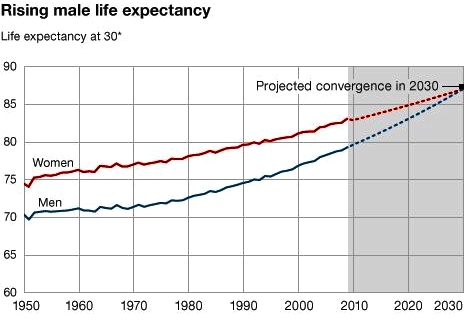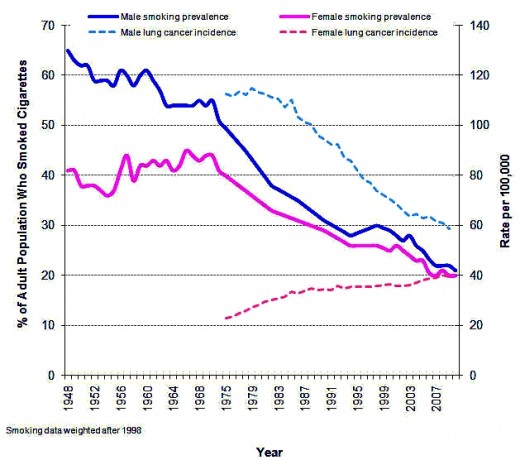Life Expectancy of Men and Women Will Soon be the Same
Men are living longer, and if current trends continues, the average age at death for men will be 87 years by 2030.
In the 1990s, Russia had one of the highest life expectancy differences of any country with women living for an average of 13 years greater than men.
Currently in the UK and US, the average woman lives 5 years longer than a man. But by 2030 the life expectancy of men and women will be the same.
Why is this occurring?
It appears that the increased life expectancy is mostly due to the lower prevalence of smoking.
However men are taking better care of themselves, and the improvements in health care for heart disease and high blood pressure is also contributing to their longer life expectancies.


In the 1970s the average woman lived for 6 years longer than men, but since then, the gap has been closing.
Life expectancies for both sexes has also been steadily increasing, which has been adding to the baby boomer bubble of older people in most societies.
If the current trend continues, Prof Mayhew, a professor of statistics at Cass Business School, in the UK, has predicted that both sexes could have the same life expectancy in 2030 at 87 years of age.

One of the major reasons for this is the rapid decline in smoking rates for men, and the more concern men are taking with their health generally. Smoking really exploded after the 1920s in the male population and reached a peak of 80% of males.
The male smoking rate was about 60% from 1950-1960 and had declined to 20% in 2010.
In contrast, women started to smoke later than men and prevalence peaked in 1968 at 45% and had fallen to about 20% in 2010, similar to the rate for men.
Rates of lung cancer are still increasing in women, but are falling fast in men (see the image).

Another reason appears to be that men are living healthier lifestyles, and are more aware of their condition and what they need to stay healthy. Other factors appear to be the decline in more hazardous jobs such as coal mining. Better health care has increased life expectancy particularly for males. People afflicted with heart disease and high blood pressure, which are more common in men, can expect to live much longer than they did a 10-20 years ago.
It is odd, but men look after their mechanical contraptions like their barbecues, cars or motorbikes, much better than their own bodies. Most men would prefer to wash their cars, do an oil change or get their motor bike serviced than book-in for a health check-up with their a doctor. But this is gradually changing.
The differences in life expectancies between men and women has been more pronounced in the west where both sexes live longer. Countries with high mortality rates, such as in central Africa, exhibit very little difference between women and men. This is due to the high rates of infectious diseases which is the common case of early death.
In the 1990s, Russia had one of the highest life expectancy differences of any country with women living for an average of 13 years greater than men.